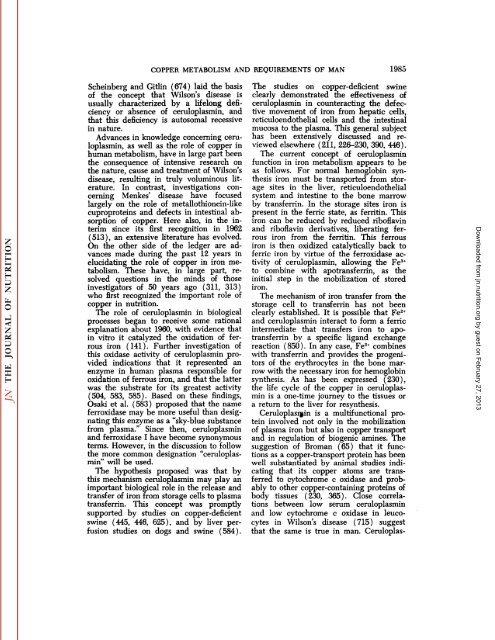conspectus of researchon copper metabolism and requirements
conspectus of researchon copper metabolism and requirements
conspectus of researchon copper metabolism and requirements
Create successful ePaper yourself
Turn your PDF publications into a flip-book with our unique Google optimized e-Paper software.
COPPER METABOLISM AND REQUIREMENTS OF MAN 1985<br />
Scheinberg <strong>and</strong> Gitlin (674) laid the basis<br />
<strong>of</strong> the concept that Wilson's disease is<br />
usually characterized by a lifelong defi<br />
ciency or absence <strong>of</strong> ceruloplasmin, <strong>and</strong><br />
that this deficiency is autosomal recessive<br />
in nature.<br />
Advances in knowledge concerning ceru<br />
loplasmin, as well as the role <strong>of</strong> <strong>copper</strong> in<br />
human <strong>metabolism</strong>, have in large part been<br />
the consequence <strong>of</strong> intensive research on<br />
the nature, cause <strong>and</strong> treatment <strong>of</strong> Wilson's<br />
disease, resulting in truly voluminous lit<br />
erature. In contrast, investigations con<br />
cerning Menkes" disease have focused<br />
largely on the role <strong>of</strong> metallothionein-like<br />
cuproproteins <strong>and</strong> defects in intestinal ab<br />
sorption <strong>of</strong> <strong>copper</strong>. Here also, in the in<br />
terim since its first recognition in 1962<br />
(513), an extensive literature has evolved.<br />
On the other side <strong>of</strong> the ledger are ad<br />
vances made during the past 12 years in<br />
elucidating the role <strong>of</strong> <strong>copper</strong> in iron me<br />
tabolism. These have, in large part, re<br />
solved questions in the minds <strong>of</strong> those<br />
investigators <strong>of</strong> 50 years ago (311, 313)<br />
who first recognized the important role <strong>of</strong><br />
<strong>copper</strong> in nutrition.<br />
The role <strong>of</strong> ceruloplasmin in biological<br />
processes began to receive some rational<br />
explanation about 1960, with evidence that<br />
in vitro it catalyzed the oxidation <strong>of</strong> fer<br />
rous iron ( 141). Further investigation <strong>of</strong><br />
this oxidase activity <strong>of</strong> ceruloplasmin pro<br />
vided indications that it represented an<br />
enzyme in human plasma responsible for<br />
oxidation <strong>of</strong> ferrous iron, <strong>and</strong> that the latter<br />
was the substrate for its greatest activity<br />
(504, 583, 585). Based on these findings,<br />
Osaki et al. (583) proposed that the name<br />
ferroxidase may be more useful than desig<br />
nating this enzyme as a "sky-blue substance<br />
from plasma." Since then, ceruloplasmin<br />
<strong>and</strong> ferroxidase I have become synonymous<br />
terms. However, in the discussion to follow<br />
the more common designation "ceruloplas<br />
min" will be used.<br />
The hypothesis proposed was that by<br />
this mechanism ceruloplasmin may play an<br />
important biological role in the release <strong>and</strong><br />
transfer <strong>of</strong> iron from storage cells to plasma<br />
transferrin. This concept was promptly<br />
supported by studies on <strong>copper</strong>-deficient<br />
swine (445, 446, 625), <strong>and</strong> by liver per<br />
fusion studies on dogs <strong>and</strong> swine (584).<br />
The studies on <strong>copper</strong>-deficient swine<br />
clearly demonstrated the effectiveness <strong>of</strong><br />
ceruloplasmin in counteracting the defec<br />
tive movement <strong>of</strong> iron from hepatic cells,<br />
reticuloendothelial cells <strong>and</strong> the intestinal<br />
mucosa to the plasma. This general subject<br />
has been extensively discussed <strong>and</strong> re<br />
viewed elsewhere (211, 226-230, 390, 446).<br />
The current concept <strong>of</strong> ceruloplasmin<br />
function in iron <strong>metabolism</strong> appears to be<br />
as follows. For normal hemoglobin syn<br />
thesis iron must be transported from stor<br />
age sites in the liver, reticuloendothelial<br />
system <strong>and</strong> intestine to the bone marrow<br />
by transferrin. In the storage sites iron is<br />
present in the ferric state, as ferritin. This<br />
iron can be reduced by reduced rib<strong>of</strong>lavin<br />
<strong>and</strong> rib<strong>of</strong>lavin derivatives, liberating fer<br />
rous iron from the ferritin. This ferrous<br />
iron is then oxidized catalytically back to<br />
ferric iron by virtue <strong>of</strong> the ferroxidase ac<br />
tivity <strong>of</strong> ceruloplasmin, allowing the Fe3*<br />
to combine with apotransferrin, as the<br />
initial step in the mobilization <strong>of</strong> stored<br />
iron.<br />
The mechanism <strong>of</strong> iron transfer from the<br />
storage cell to transferrin has not been<br />
clearly established. It is possible that Fe2+<br />
<strong>and</strong> ceruloplasmin interact to form a ferric<br />
intermediate that transfers iron to apo<br />
transferrin by a specific lig<strong>and</strong> exchange<br />
reaction (850). In any case, Fe3* combines<br />
with transferrin <strong>and</strong> provides the progeni<br />
tors <strong>of</strong> the erythrocytes in the bone mar<br />
row with the necessary iron for hemoglobin<br />
synthesis. As has been expressed (230),<br />
the life cycle <strong>of</strong> the <strong>copper</strong> in ceruloplas<br />
min is a one-time journey to the tissues or<br />
a return to the liver for resynthesis.<br />
Ceruloplasmin is a multifunctional pro<br />
tein involved not only in the mobilization<br />
<strong>of</strong> plasma iron but also in <strong>copper</strong> transport<br />
<strong>and</strong> in regulation <strong>of</strong> biogenic amines. The<br />
suggestion <strong>of</strong> Broman (65) that it func<br />
tions as a <strong>copper</strong>-transport protein has been<br />
well substantiated by animal studies indi<br />
cating that its <strong>copper</strong> atoms are trans<br />
ferred to cytochrome c oxidase <strong>and</strong> prob<br />
ably to other <strong>copper</strong>-containing proteins <strong>of</strong><br />
body tissues (230, 365). Close correla<br />
tions between low serum ceruloplasmin<br />
<strong>and</strong> low cytochrome c oxidase in leuco<br />
cytes in Wilson's disease (715) suggest<br />
that the same is true in man. Ceruloplas-<br />
Downloaded from<br />
jn.nutrition.org<br />
by guest on February 27, 2013
















